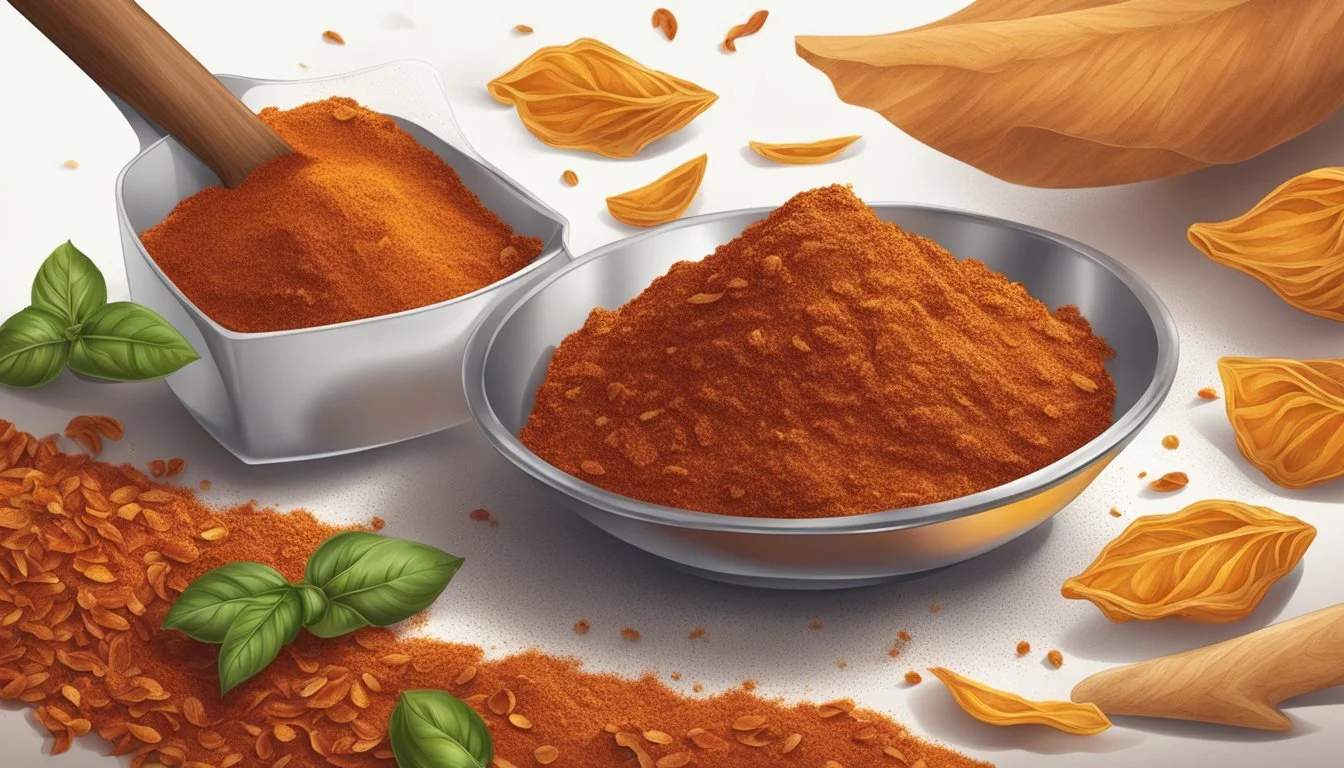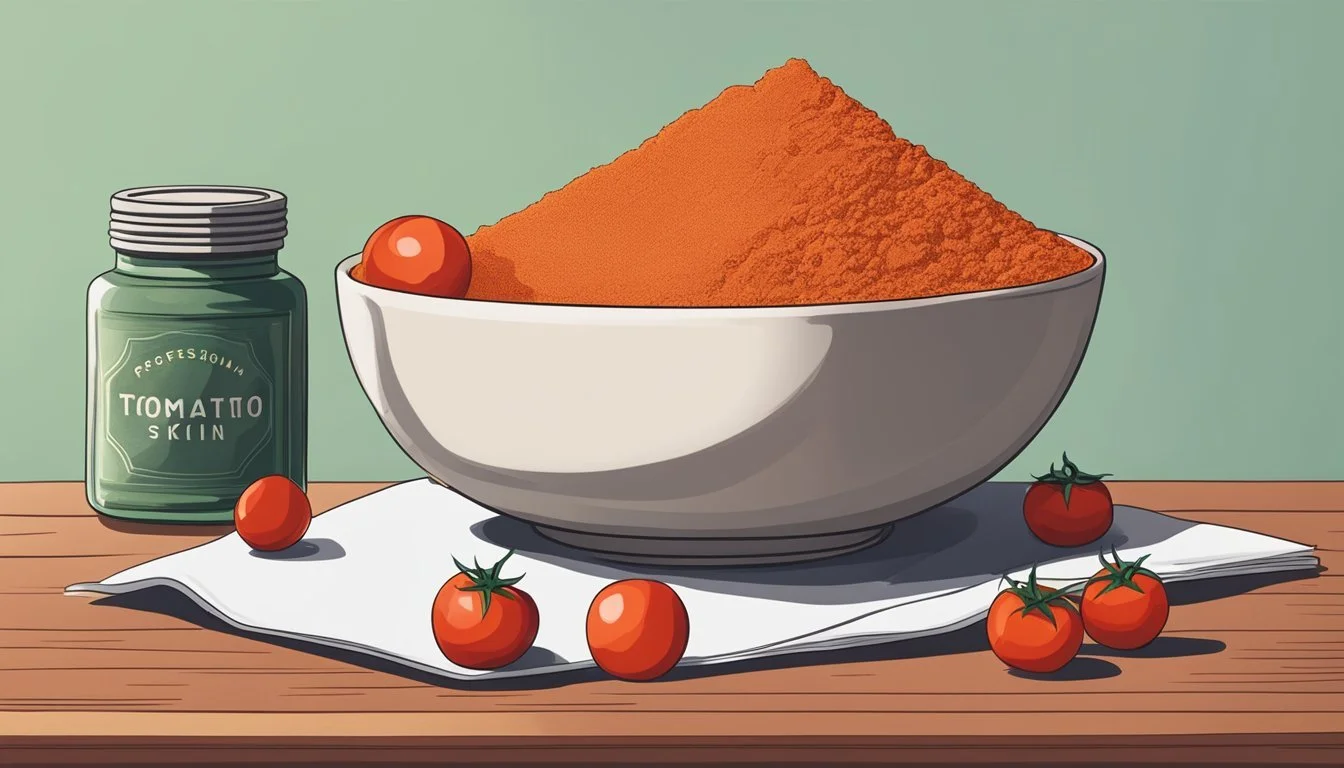Tomato Skin Powder
A Umami-Rich Seasoning for Culinary Innovation
Tomato skin powder is emerging as a noteworthy addition in the culinary world, offering a concentrated source of umami—the savory flavor that deepens the taste experience of a dish. As the recognition for umami as a fundamental taste alongside sweet, sour, salty, and bitter grows, so does the appreciation for ingredients that naturally enhance this savory quality. Tomato skins, often discarded as waste, are packed with flavor and when dried and ground into a powder, they become a versatile and waste-reducing seasoning.
The process of transforming tomato skins into powder involves drying the skins until they are brittle and can be easily crumbled. This method of preparation preserves their umami essence and intensifies the flavor. The resulting tomato skin powder can be used to add depth to a variety of dishes, from soups and sauces to rubs and marinades, infusing them with a rich, savory tomato profile.
As consumers seek out natural ways to augment flavor in cooking without relying on artificial enhancers, tomato skin powder presents a sustainable and flavorful solution. It not only utilizes a part of the tomato that is typically overlooked but also offers home cooks and professional chefs alike the opportunity to elevate their dishes with the distinct umami characteristic inherent in tomatoes (What wine goes well with tomatoes?).
The Concept of Umami
Umami, often referred to as the "fifth taste," is a complex and savory flavor that is distinct from the traditional four tastes of sweet, sour, salty, and bitter. It plays a significant role in food perception and flavor enhancement.
Understanding Umami: The Fifth Taste
Umami is a taste that can be described as savory or meaty, and it is one of the five basic tastes that the human palate can detect. Unlike the other tastes, umami is not as immediately recognizable, but it provides depth to a wide range of foods. It's particularly prominent in foods rich in glutamate, an amino acid that imparts this distinctive flavor.
Historical Perspective of Umami
The term "umami" comes from a Japanese word meaning "pleasant savory taste" and was coined in 1908 by Kikunae Ikeda, a chemist at Tokyo Imperial University. Ikeda identified glutamic acid as the compound that gives dashi, a traditional Japanese seaweed broth, its unique taste. Umami is recognized for enhancing the palatability of dishes by melding and balancing the other four basic tastes.
Chemistry Behind Umami
The savory quality of umami is due to the presence of glutamic acid and its salts (glutamates), which occur naturally in many foods. These compounds interact with specific taste receptors on the tongue to elicit the umami perception. In addition to glutamate, other umami substances include inosinate and guanylate, which are nucleotides that often derive from animal proteins and certain vegetables, respectively. When these compounds are present together, they create a synergistic effect that intensifies the umami flavor.
Tomato Skin Powder
Tomato Skin Powder transforms unused tomato skins into a flavor-packed seasoning, offering both a practical solution to food waste and a secret ingredient for enhancing a wide range of recipes. Utilizing this powder can intensify the umami qualities of dishes while also tapping into the nutritional benefits tomatoes naturally provide.
Preparation of Tomato Skin Powder
To create tomato skin powder, one must start with properly dehydrated tomato skins. This can be achieved using a dehydrator, oven, or air fryer. For the oven method, spread the skins in a single layer on a cookie sheet lined with parchment paper and dehydrate at 140°F for approximately 8-10 hours, ensuring to flip them halfway through. If using an air fryer, place the skins on the trays and dehydrate at 125°F for around 4 hours, checking and extending the time if necessary. For those favoring the microwave, lay the skins on a paper-towel-lined microwave-safe plate, and use high power for 4-minute intervals, checking every 20 seconds until dry.
Nutritional and Health Benefits
Tomato skin powder is not only flavor-rich but also boasts significant health benefits. Tomato skins contain a high concentration of antioxidants, such as lycopene, which has been linked to reducing the risk of certain diseases. Additionally, the powder is a good source of dietary fiber and can contribute to a balanced diet. Using the powder in cooking can help enhance these benefits while lowering food waste.
Culinary Applications
Tomato skin powder is versatile in the kitchen and can be incorporated into numerous recipes to add richness and flavor. It is particularly effective as a seasoning; a sprinkle can elevate roasted vegetables, popcorn, or salads. Additionally, tomato powder can be mixed with water to reconstitute it into tomato paste or to craft instant tomato soup or juice, offering a convenient and tasty solution for quick cooking applications. The recommended ratio for reconstitution into paste is 1 part tomato powder to 2 parts water.
Culinary Use and Recipes
Tomato skin powder serves as a versatile and potent additive, enhancing recipes with its distinct umami taste, which is considered the fifth basic taste profile. It can introduce a depth of flavor to a variety of dishes, transcending mere garnishing to actively shape and balance the palate experience.
Incorporating Into Recipes
Tomato skin powder excels in imparting a savory quality to foods without adding moisture. Cooks can sprinkle it into meats for a richer taste or mix it into doughs for pasta and bread to infuse layers of flavor. Recipe versatility is one of its strengths; a small amount can take a simple dish like scrambled eggs to new heights of deliciousness.
Meatballs/Meatloaf: Enhance the tomato intensity by blending the powder into the meat mixture.
Pizza Sauce: Create a quick sauce with tomato powder, water, and seasonings like oregano, basil, and garlic powder.
Curry Sauces/Beef Stew: (What wine goes well with beef stew?) Incorporate into sauces and stews for an extra savory punch.
When cooking, use the tomato skin powder sparingly as a flavor enhancer—it is potent and can easily dominate the intended taste profile of your dish.
Creating Balanced Flavor Profiles
To achieve a harmonious flavor balance, chefs employ tomato skin powder in tandem with other ingredients. The powder's savory nature pairs well with both proteins like steak and a variety of vegetables, acting as a flavor bridge that ties a dish together. It amplifies the natural flavors present, adding a desirable complexity and richness.
Sauces: For tomato-based sauces, (What wine goes well with tomato-based sauces?) an addition of the powder can enrich the existing taste and add complexity to the sauce's flavor profile.
Vegetable Dishes: A sprinkle on roasted or grilled vegetables can elevate their inherent sweetness with a complementary savory note.
Leveraging tomato skin powder involves more than mere application; it requires an understanding of the ingredients' interplay to craft a compelling and balanced taste experience in the culinary field.
Umami-Rich Ingredients
The allure of umami-rich ingredients lies in their ability to enhance the meaty and brothy qualities of dishes. They act upon the taste buds to impart a subtle, yet profound depth of flavor.
Sources of Umami
Umami is a taste profile that is often described as the fifth basic taste alongside sweet, sour, bitter, and salty. It is typically associated with a savory, meaty flavor. Several natural ingredients are high in glutamates, which are compounds that provide this distinctive umami taste. These include:
Mushrooms: Particularly dried shiitake, known for their concentrated umami.
Soy: Used in forms like soy sauce and miso, which are staple umami contributors.
Parmesan: An aged cheese, it's high in glutamates providing a strong umami punch.
Kombu: A type of seaweed often used in Japanese cooking to infuse dishes with umami.
Tomatoes: Sun-dried tomatoes, in particular, have a concentrated umami flavor due to their high glutamate content.
Complementary Ingredients
Some ingredients may not be umami-rich themselves but work well in enhancing the umami flavor when combined with the above sources. Examples include:
Garlic and Onion: These aromatic vegetables complement umami flavors by adding complexity.
Aged Cheeses (What wine goes well with aged cheeses?): Beyond Parmesan, other aged cheeses like Gruyère can augment umami.
Meat and Vegetables: When cooked, these ingredients develop rich flavors that meld well with umami components.
Fermentation and Aging
The processes of fermentation and aging are pivotal in concentrating the umami flavor in food items.
Fermentation: This method is used to create foods like soy sauce, miso, and fermented vegetables, all of which are umami-rich.
Aging: Aging allows enzymes and beneficial bacteria to break down proteins into amino acids, increasing glutamate levels and, therefore, umami in foods like cheeses and cured meats (What wine goes well with cured meats?).
These processes not only amplify the natural umami essence but also add complexity to the flavor profile of ingredients.
Umami in Different Cuisines
Umami, often referred to as the fifth taste, is a cornerstone of flavors in various cuisines around the world. It can be found in specific ingredients and is known to enhance the overall taste profile of dishes.
Umami in Japanese Cooking
In Japanese cuisine, umami is a fundamental element that imparts a deep, savory character to food. Key ingredients that contain umami include soy sauce, miso, kombu seaweed, and shiitake mushrooms. A quintessential example is dashi, a foundational broth in Japanese cooking, which derives its umami primarily from kombu and often includes shiitake mushrooms or bonito flakes. Miso soup, another staple, utilizes fermented soybean paste (miso) that is rich in umami.
Key Japanese Umami Ingredients:
Soy Sauce: A versatile condiment made from fermented soybeans.
Miso: A fermented soybean paste used in soups and sauces.
Kombu Seaweed: A sea vegetable used to make dashi broth.
Shiitake Mushrooms: Dried or fresh, used for their umami quality.
Global Interpretation and Use
Globally, chefs and home cooks incorporate umami-rich ingredients to boost the savory flavor of their dishes. Parmesan cheese, known for its high umami content, is used across many Italian recipes, adding depth to pasta dishes and risottos. Sun-dried tomatoes and fish sauce provide potent umami punches and are used across a variety of cuisines from Mediterranean to Southeast Asian. MSG, or monosodium glutamate, is a flavor enhancer that is utilized worldwide to impart umami in everything from snacks to main course dishes.
Global Umami Ingredients:
Parmesan Cheese: Offers a nutty and umami flavor in European cuisine.
Sun-dried Tomatoes: Intense umami taste, used in Mediterranean dishes.
Mushrooms: Various types provide umami, especially when dried.
Fish Sauce: A key ingredient in Southeast Asian cooking, rich in umami.
MSG: A concentrated source of umami, often added to dishes for instant savoriness.
Across continents, umami is celebrated and skillfully integrated into local culinary traditions, showcasing its versatility and universal appeal.
Seasoning with Tomato Skin Powder
Tomato skin powder is becoming a staple for adding a mouthwatering umami component to various dishes. This dehydrated delicacy offers a pleasant savory taste that can elevate both the flavor and aroma of your culinary creations.
Optimal Pairings and Ratios
Tomato skin powder pairs exceptionally well with foods that crave a hint of earthiness or a pop of savory flavor. Chefs often recommend incorporating it in a 1:1 ratio with salt to create a balanced seasoning blend. It complements the natural sweetness of vegetables like asparagus and Brussels sprouts, and enhances the richness of stews and seafood.
Steaks: A pinch can intensify the natural flavors
Vegetarian dishes (What wine goes well with vegetarian dishes?): Use liberally to add depth
Enhancing Dishes with Umami
The umami component of tomato skin powder is akin to that of soy sauce or Parmesan, offering an additional layer of flavor complexity. When seasoning dishes, one should consider the existing flavors and determine how the earthiness of tomato powder can amplify the overall taste profile without overwhelming it.
Soups: A tablespoon can transform a simple broth into a flavor-packed experience.
Savory bakes: Infuse the dough with a small amount for an umami twist.
Creative Uses in Kitchen
Beyond traditional uses, tomato skin powder proves to be versatile in a range of culinary applications. It's not just limited to savory dishes; creative chefs have found it to be an excellent addition to enhance the flavor profile of their recipes.
Popcorn topping: Sprinkle over popcorn for an instant taste lift.
Homemade seasonings: Combine with other spices to create custom blends.
Considerations for Using Tomato Skin Powder
Tomato skin powder serves as a dynamic ingredient that can elevate dishes with its umami-rich flavor. However, it’s important to consider dietary sensitivities and proper storage methods to maintain its quality and flavor balance.
Sensitivities and Dietary Restrictions
Individuals with certain food sensitivities must be aware that tomato skin powder can concentrate natural compounds found in tomatoes, like monosodium glutamate (MSG), which is responsible for the umami flavor. While MSG is generally recognized as safe (GRAS), some people may experience adverse reactions to it.
Allergies: Rarely, tomatoes can cause allergies and the same reaction can be expected from the skin powder.
Histamine Intolerance: Tomatoes are high in histamines and drying them can increase concentration.
Storing and Preserving
The shelf-life and quality of tomato skin powder depend on its storage. Moisture is the enemy of dried powders as it can lead to spoilage and clumping.
Optimal Conditions: Store in an airtight container in a cool, dark place.
Moisture Control: Include a desiccant pack to absorb any excess moisture.
Shelf-Life: Properly dehydrated and stored, tomato skin powder can last up to a year.
Future Trends and Research
As the food industry continues to evolve, tomato skin powder is gaining recognition for its ability to enhance flavor profiles with a rich umami character. Research and innovation in this sector are paving the way for new applications and a deeper understanding of umami's role in culinary science.
Advancements in Umami Research
Recent studies in food science have deepened the understanding of umami, particularly regarding its synergistic relationship with other flavor compounds. Scientists are investigating the precise mechanisms through which umami-rich ingredients like tomato skin powder enhance flavors when combined with various seasonings. This research is crucial for the development of new seasoning blends that leverage umami for maximum flavor enhancement.
Key Areas of Focus:
Interaction of umami with other basic tastes
Molecular basis of umami perception
Health benefits and nutritional value of umami compounds
Innovations in Seasoning
The food industry is witnessing a trend towards natural and clean-label products, with tomato skin powder positioned as a promising ingredient. Innovations are geared towards optimizing the production of tomato skin powder to maintain its flavor integrity and nutritional value.
Emerging Technologies:
Extrusion: Improves powder solubility and preservation of flavor
Microencapsulation: Protects flavor compounds during processing and storage
The industry is also exploring sustainable practices in sourcing and processing tomato skins, reducing waste, and improving the ecological footprint of seasoning production. These innovations are shaping a future where flavor, health, and sustainability converge.








